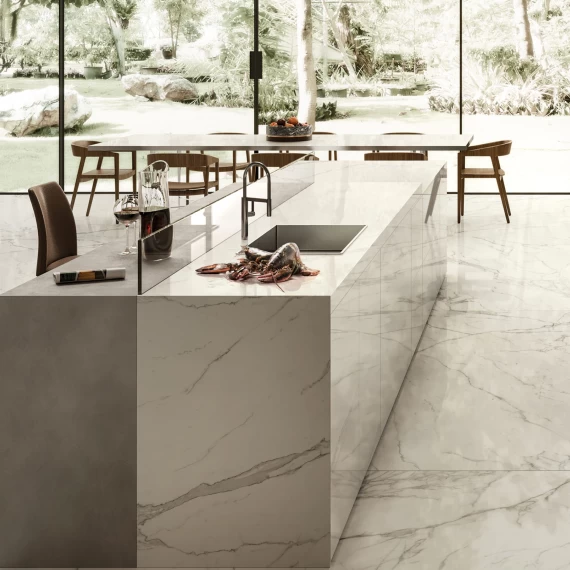
Lappato porcelain tiles
When it comes to tile finishes that are suited for both walls and floors, lappato tiles are prime considerations for any project that calls for a luxury look. These tiles are known for their durability and exceptional beauty, and they have an exceptional aesthetic that adds to their appeal to create signature spaces. For interior designers and architects who prefer using porcelain stoneware in their design and layouts, lappato tiles are often a preferred choice with a lot of design variety. Lappato tiles provide a fantastic balance between matt and polished surfaces, creating exceptional style.

Lappato tiles: meaning and definition
What are lappato porcelain tiles? The lappato meaning refers to porcelain tiles that have been polished according to a certain process. Their surfaces are polished, but not completely. This gives these types of tiles a natural look that is part glossy, part matt. Thanks to their thin glazes, lappato tiles can easily match different decor styles, as their subtle colours can seamlessly blend into different colour schemes. Therefore, for those interior designers or architects who are looking for understated tile styles, lappato tiles can be a good idea. These are, however, not rectified porcelain tiles.

Lappato tiles: pros and cons
Whether you plan to install lappato floor tiles, or want to get the look for walls as well, there are some pros and cons you need to consider.

Pros of lappato porcelain stoneware
- Several shapes and styles are available, making lappato tiles versatile options to personalise any space.
- These types of finishes bring a lot of elegance and sophistication to living spaces.
- Thanks to their shiny character, lappato tiles can easily make a room look bigger.
- Lappato tiles are very easy to clean and are low maintenance.
- They are scratch-resistant and can withstand a lot of foot traffic.
- Lappato tiles are moisture-resistant, which makes them ideal for bathrooms.
- Thanks to their weather resilience, these tiles can be used outside as well on patios and balconies.

Cons of lappato porcelain stoneware
- Low skid resistance, which could make it a finish that is not ideal for a home with pets or small children.
- Regular waxing and maintenance are needed to keep these tiles in perfect condition.
Lappato vs natural: how to choose
The beauty of lappato vs natural tiles is that you do not have to choose. These two tile types can be used together to create beautiful designs for entryways and bathrooms, as examples. Thanks to lappato tiles’ highlighting effect, they look fantastic in any setting, giving a contemporary touch to both floors and walls.

How to clean lappato tiles
The process of cleaning lappato tiles is very much the same as how to clean matte porcelain tiles. Before washing your floors, sweep first to remove any dust and debris. Use neutral cleaning products that will not damage the shiny surfaces of your tiles, and use hot water during the cleaning process. Keep in mind that with extra care, lappato tiles surfaces will be able to last longer.
Get in touch with the Atlas team today to find out more about our available lappato tile options.



